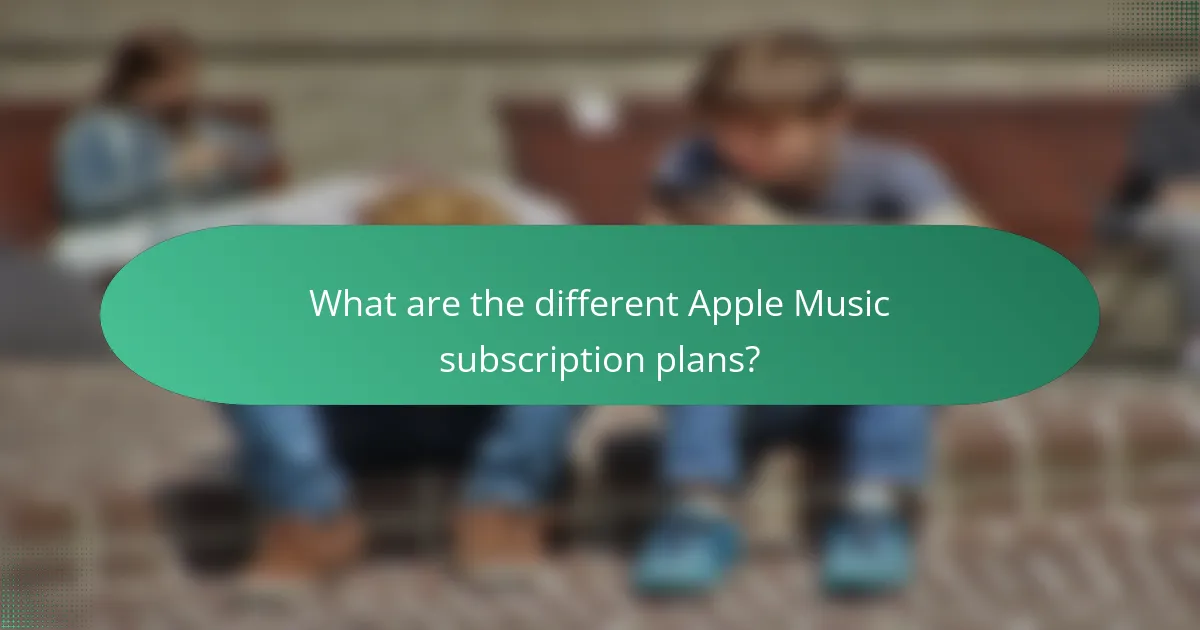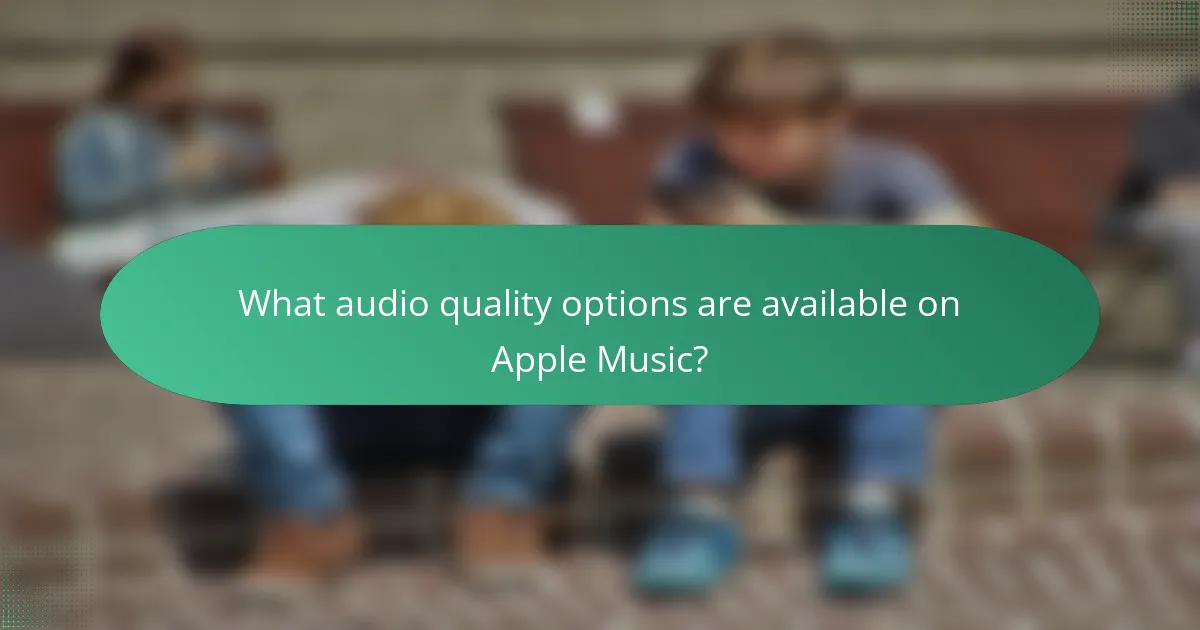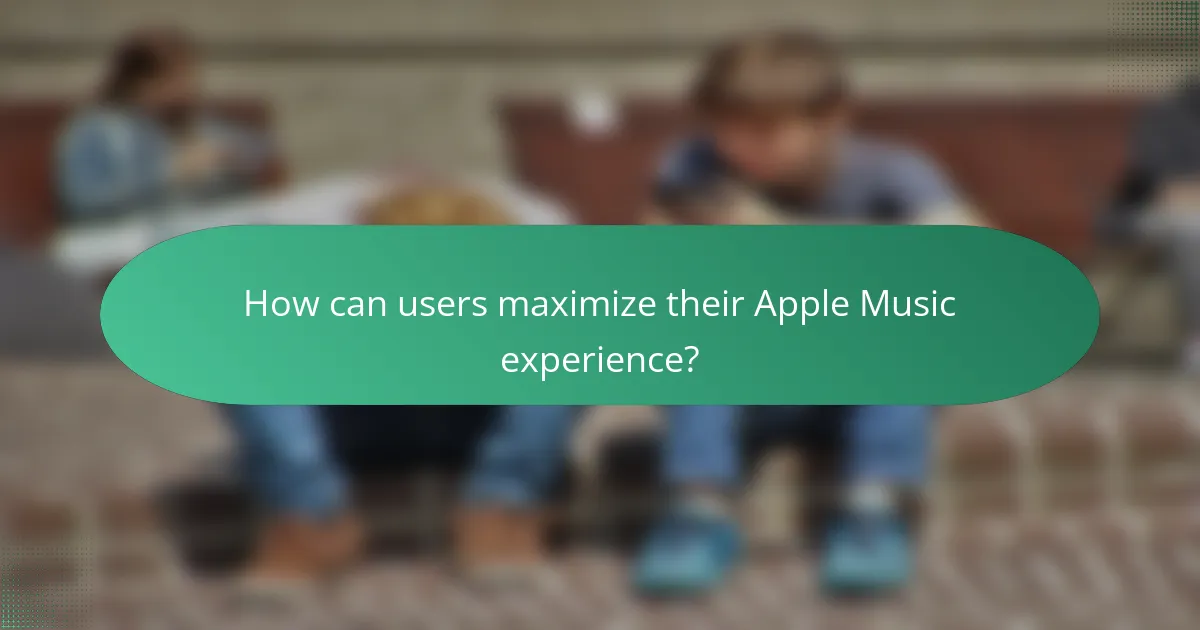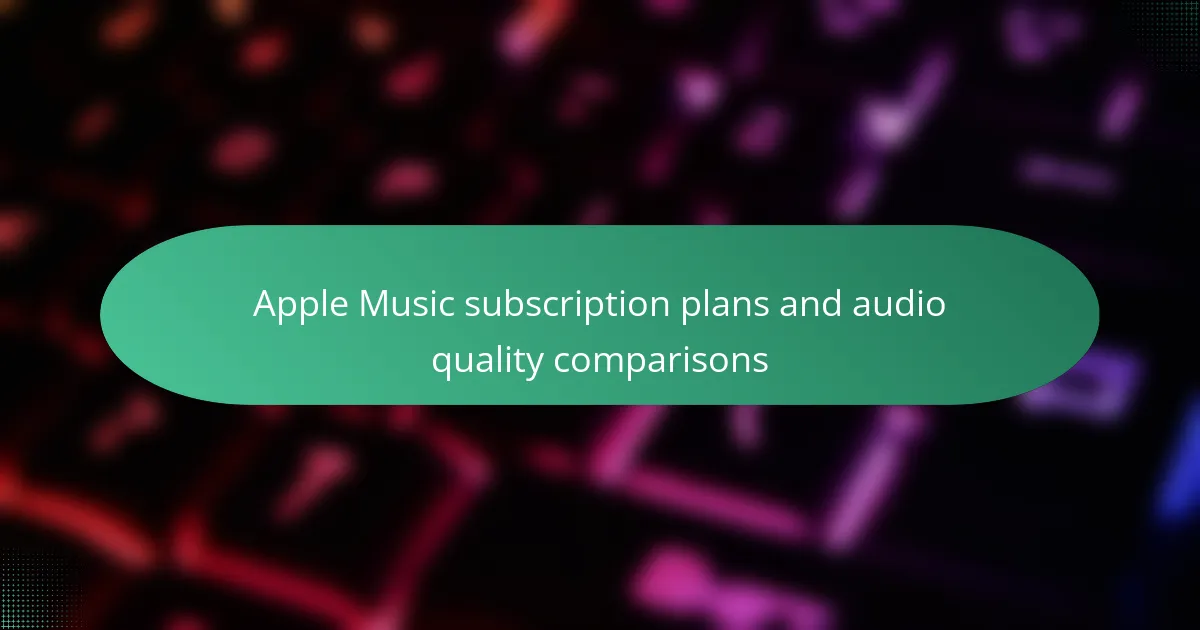Apple Music is a music streaming service that offers three subscription plans: Individual for $9.99 per month, Family for $14.99 per month (up to six users), and Student for $4.99 per month. All plans grant access to the full Apple Music library and include features such as offline listening and curated playlists. The service provides various audio quality options, including High Efficiency, High Quality, Lossless, and Spatial Audio with Dolby Atmos, catering to different user preferences and bandwidth conditions. Additionally, users can enhance their experience through personalized recommendations, social features, and integration with Siri for hands-free control.

What are the different Apple Music subscription plans?
Apple Music offers three main subscription plans. The Individual plan costs $9.99 per month. The Family plan allows up to six people for $14.99 per month. The Student plan is available for $4.99 per month. Each plan provides access to the entire Apple Music library. All plans include features like offline listening and personalized playlists.
How do the individual and family plans differ?
Individual plans offer access for a single user, while family plans allow multiple users under one subscription. Individual plans typically cost less than family plans. Family plans can accommodate up to six members. Each user on a family plan has their own personal library and recommendations. Individual plans provide a personalized experience for one person only. Family plans are designed for shared access among family members. This structure allows families to enjoy music together while maintaining individual preferences.
What are the costs associated with each subscription type?
Apple Music offers three subscription types with varying costs. The Individual plan costs $9.99 per month. The Family plan, which allows sharing with up to six family members, costs $14.99 per month. The Student plan is available for $4.99 per month for eligible students. These prices reflect the standard rates as of October 2023. Each plan provides access to the same music library and audio quality features.
What features are exclusive to the family plan?
The family plan offers features exclusive to multiple users sharing one subscription. It allows up to six family members to access Apple Music under a single account. Each member gets their own personal music library and recommendations. Family members can create and share playlists individually. The plan includes family sharing of purchased music and content. Family plans also support family sharing features for subscriptions and app purchases. These features enhance the overall experience for families using Apple Music together.
What is the student plan and how does it work?
The student plan is a discounted subscription option for Apple Music. It allows eligible students to access the full Apple Music catalog at a reduced price. Students must verify their status through a third-party service like UNiDAYS. The plan typically offers a 50% discount compared to the standard individual plan. This makes it affordable for students to enjoy music streaming. The student plan renews automatically after the initial period. Users can cancel anytime without penalties. This plan is available in multiple regions, making it widely accessible.
What discounts are available for students?
Apple Music offers a student discount of 50% off the standard subscription price. This discount is available to eligible college students who verify their student status through a third-party service. The student plan allows access to all features of Apple Music, including millions of songs and curated playlists. According to Apple, students can enjoy this discount for up to four years, provided they remain enrolled in an eligible institution. This makes Apple Music more accessible for students seeking affordable streaming options.
How long can students maintain their subscription at a discounted rate?
Students can maintain their Apple Music subscription at a discounted rate for up to four years. This discount is available for eligible students who verify their status through a third-party service. The subscription renews at the discounted rate as long as the student remains eligible. After four years, the subscription will revert to the standard pricing unless canceled.
Are there any special promotional offers for new subscribers?
Yes, Apple Music offers special promotional offers for new subscribers. Typically, new users can access a free trial period. This trial often lasts for three months. During this time, users can explore all features without charge. After the trial, users can choose a paid subscription plan. Promotions may vary based on region or time of year. For the most accurate information, users should check the Apple Music website directly.
What are the typical promotional periods for Apple Music?
Apple Music typically offers promotional periods during major events and holidays. Common promotional periods include back-to-school promotions in late summer and holiday promotions in December. Additionally, Apple often provides extended free trials for new users during specific marketing campaigns. These promotions can vary in duration, often lasting from one month to three months. The company has also been known to offer discounts for students and family plans during promotional events.
How do promotional offers affect subscription plans?
Promotional offers significantly influence subscription plans by attracting new users and increasing retention rates. These offers often include discounts, free trials, or bundled services. For instance, a 3-month free trial can entice users to try Apple Music without immediate financial commitment. Research shows that 60% of users are more likely to subscribe after experiencing a promotional offer. Additionally, promotional offers can create urgency, encouraging immediate sign-ups. This strategy effectively boosts subscriber numbers and enhances customer loyalty.

What audio quality options are available on Apple Music?
Apple Music offers several audio quality options. These include High Efficiency, High Quality, Lossless, and Spatial Audio with Dolby Atmos. High Efficiency streams at 64 kbps, suitable for low-bandwidth situations. High Quality streams at 256 kbps using AAC format. Lossless audio starts at CD-quality 16-bit/44.1 kHz and goes up to 24-bit/192 kHz. Spatial Audio enhances the listening experience with immersive sound. Users can adjust these settings in the app under Audio Quality preferences.
What are the different audio formats supported by Apple Music?
Apple Music supports several audio formats. The primary formats include AAC (Advanced Audio Codec) at 256 kbps. Apple Music also supports lossless audio formats, including ALAC (Apple Lossless Audio Codec). Additionally, it offers high-resolution audio up to 24-bit/192 kHz. These formats ensure high-quality sound for streaming and downloads. The use of AAC is standard for most streaming services, providing a balance between quality and file size. ALAC allows for lossless compression, preserving original sound quality. High-resolution audio caters to audiophiles seeking superior sound fidelity.
How does lossless audio differ from standard audio quality?
Lossless audio differs from standard audio quality by preserving the original sound without any compression. Standard audio formats, like MP3, reduce file size by removing some audio data. This can lead to a loss in sound quality and detail. Lossless formats, such as FLAC or ALAC, retain all audio data. Consequently, lossless audio provides a richer listening experience with greater clarity. According to Apple, lossless audio can deliver up to 24-bit/192 kHz quality. This high fidelity is especially noticeable in complex music arrangements. In contrast, standard audio typically caps at 16-bit/44.1 kHz. Therefore, lossless audio is ideal for audiophiles seeking optimal sound reproduction.
What is the significance of spatial audio in Apple Music?
Spatial audio in Apple Music enhances the listening experience by providing immersive sound. It allows users to hear music in a three-dimensional space. This technology uses Dolby Atmos to create a surround sound effect. It makes songs feel more dynamic and engaging. Spatial audio is significant because it offers a new way to experience music. It adds depth and clarity that traditional stereo sound cannot achieve. Many artists are now releasing music mixed specifically for spatial audio. This trend highlights its growing importance in the music industry.
How does Apple Music’s audio quality compare to other streaming services?
Apple Music offers high-quality audio streaming, comparable to other leading services. It supports Lossless Audio up to 24-bit/192 kHz. This feature enhances sound fidelity significantly. In contrast, Spotify offers a maximum of 320 kbps in its premium tier. Tidal provides HiFi streaming with a similar lossless option. Amazon Music Unlimited also features HD and Ultra HD audio. Apple Music’s audio quality stands out due to its integration of Dolby Atmos for spatial audio. This immersive experience is not universally available across all streaming platforms. Overall, Apple Music’s audio quality ranks among the best in the industry.
What are the key differences in sound quality between Apple Music and Spotify?
Apple Music offers lossless audio quality, while Spotify uses lossy compression. Apple Music streams at up to 24-bit/192 kHz. This provides a richer sound experience. Spotify’s highest quality is 320 kbps using Ogg Vorbis codec. Apple Music’s lossless format retains more detail and dynamic range. Spotify’s compression can lead to loss of audio fidelity. Apple Music also includes spatial audio features with Dolby Atmos. This enhances the immersive listening experience. In contrast, Spotify does not currently support spatial audio.
How does audio quality impact user experience on Apple Music?
Audio quality significantly impacts user experience on Apple Music. Higher audio quality enhances clarity and detail in music. Users can appreciate nuances that lower quality may obscure. This improvement leads to greater listener satisfaction. Apple Music offers lossless audio options to cater to audiophiles. Research indicates that 96% of users prefer higher quality sound. This preference influences subscription choices among users. Overall, audio quality is a critical factor in the enjoyment of music on the platform.
What devices support high-quality audio streaming on Apple Music?
Apple Music supports high-quality audio streaming on various devices. These include iPhones and iPads running iOS 14.6 or later. Mac computers with macOS Monterey or later also support this feature. Additionally, Apple TV 4K supports high-quality audio streaming. HomePod and HomePod mini speakers can stream high-quality audio as well. Android devices with the latest version of the Apple Music app also support high-quality streaming. This information is validated by Apple’s official guidelines on supported devices for their music streaming services.
Which Apple devices are optimized for lossless audio playback?
Apple devices optimized for lossless audio playback include iPhone models starting from iPhone 8, iPad models from the 6th generation, and Mac computers running macOS Monterey or later. Additionally, the Apple TV 4K supports lossless audio playback. These devices utilize advanced hardware and software capabilities to deliver high-fidelity audio experiences. Lossless audio playback is available through the Apple Music app for subscribers. This feature allows users to enjoy music in its original quality without compression.
Are there any third-party devices compatible with Apple Music’s audio quality features?
Yes, there are third-party devices compatible with Apple Music’s audio quality features. Devices such as certain high-fidelity headphones and speakers support lossless audio. Examples include specific models from brands like Sonos and Bose. These devices can stream Apple Music in high-resolution formats. Apple Music’s lossless audio quality is available on compatible devices. Users need to ensure their device settings are configured for high-quality streaming. This compatibility enhances the listening experience for audiophiles.

How can users maximize their Apple Music experience?
Users can maximize their Apple Music experience by utilizing features like curated playlists, offline listening, and personalized recommendations. Curated playlists are created by experts and can introduce users to new music. Offline listening allows users to download songs for playback without internet access. Personalized recommendations are based on listening habits, ensuring users discover music suited to their tastes. Additionally, enabling lossless audio and spatial audio enhances the listening experience with higher quality sound. Apple Music also offers integration with Siri for hands-free control. Engaging with Apple Music’s social features allows users to share playlists and follow friends for music inspiration.
What tips can enhance the audio quality for users?
To enhance audio quality for users, consider using high-quality headphones or speakers. Investing in premium audio equipment can significantly improve sound clarity. Ensure that your audio files are of high resolution, such as lossless formats. This prevents loss of detail during playback. Adjusting the equalizer settings can also tailor the sound to personal preferences. Reducing background noise in the environment aids in clearer listening experiences. Additionally, using a wired connection instead of Bluetooth can minimize audio compression. Regularly updating your music app ensures optimal performance and access to the latest features.
How can users adjust settings for optimal sound quality?
Users can adjust settings for optimal sound quality in Apple Music by navigating to the app’s settings menu. First, they should select “Audio Quality.” Here, options for lossless audio and high-resolution lossless audio are available. Enabling lossless audio enhances the music quality significantly. Users can also choose between different streaming quality settings, including high efficiency and high quality. Selecting “Download” settings allows users to specify the audio quality for downloaded songs. Additionally, users should ensure that their device supports the highest quality settings. Regular updates to the app may also improve sound quality features.
What headphones or speakers are recommended for the best listening experience?
High-end headphones like the Sony WH-1000XM4 and the Sennheiser HD 800 S are recommended for the best listening experience. These models provide exceptional sound quality and comfort. The Sony WH-1000XM4 features industry-leading noise cancellation and a balanced sound profile. The Sennheiser HD 800 S is known for its wide soundstage and clarity. For speakers, the KEF LS50 Wireless II offers high fidelity and versatility. The Audioengine A5+ Wireless delivers rich sound and solid bass. These devices enhance the audio quality of Apple Music, especially with lossless streaming.
How can users explore and discover new music on Apple Music?
Users can explore and discover new music on Apple Music through various features. The “For You” section curates personalized recommendations based on listening habits. Users can also browse playlists created by Apple Music editors. The “Browse” tab showcases new releases, top charts, and genre-specific collections. Additionally, users can utilize the “Radio” feature for live shows and curated playlists. The “Search” function allows users to find specific artists, albums, or songs. Apple Music also offers a “Listen Now” feature that highlights trending tracks and playlists. These tools collectively enhance the music discovery experience on the platform.
What features aid in music discovery and personalization?
Music discovery and personalization features include curated playlists, algorithm-driven recommendations, and user-generated playlists. Curated playlists are created by experts to introduce users to new music. Algorithm-driven recommendations analyze listening habits to suggest songs and artists. User-generated playlists allow users to share their music preferences with others. These features enhance the listening experience and help users find music that aligns with their tastes. According to Apple Music, personalized playlists like “For You” are updated regularly based on user activity. This approach increases user engagement and satisfaction with the service.
How can users create and share playlists effectively?
Users can create and share playlists effectively by utilizing the features available in Apple Music. First, they can create a playlist by selecting ‘New Playlist’ in the app. Users should then add songs by searching or browsing their library. They can organize tracks by dragging them into the desired order. Sharing options include selecting ‘Share Playlist’ and choosing a method such as AirDrop, Messages, or social media. Apple Music allows users to collaborate on playlists by inviting friends to add songs. This feature enhances engagement and personalization. According to Apple, playlists can be shared with anyone, even those without a subscription, increasing accessibility.
What are some common troubleshooting tips for Apple Music subscriptions?
To troubleshoot Apple Music subscriptions, first ensure your subscription is active. Check your Apple ID settings for subscription status. Restart the Apple Music app to resolve minor glitches. Update your device to the latest software version for compatibility. Sign out and sign back into your Apple ID to refresh the connection. Verify your payment method is valid and up-to-date. Clear the app’s cache if it’s not loading content properly. Contact Apple Support for persistent issues, as they can provide tailored assistance.
How can users resolve playback issues related to audio quality?
Users can resolve playback issues related to audio quality by adjusting their streaming settings. First, check the audio quality settings in the Apple Music app. Users can select options like High Efficiency, High Quality, or Lossless. Each option affects the data rate and overall sound quality.
Next, ensure that the device’s internet connection is stable. A weak connection can lead to buffering and reduced audio quality. Users should consider using Wi-Fi instead of cellular data for better performance.
Additionally, users can update the Apple Music app to the latest version. Updates often include bug fixes that can improve playback quality.
Finally, if issues persist, restarting the device can clear temporary glitches. This simple action can often resolve unexpected playback problems.
What steps should be taken if subscription features are not accessible?
Check your subscription status in the Apple Music app. Ensure that your payment method is valid and up to date. Restart the app to refresh its functionality. Sign out of your Apple ID and then sign back in. Update the app to the latest version available. Check for any service outages on the Apple System Status page. If issues persist, contact Apple Support for assistance. These steps are effective based on common troubleshooting practices for app accessibility issues.
Apple Music is a music streaming service that offers various subscription plans, including Individual, Family, and Student options, each providing access to the entire music library and unique features. The article outlines the costs associated with each plan, highlights the differences between Individual and Family plans, and details the benefits of the Student plan. Additionally, it explores the audio quality options available on Apple Music, including Lossless and Spatial Audio, and compares these features with other streaming services. Key tips for maximizing the Apple Music experience, troubleshooting subscription issues, and enhancing audio quality are also discussed.
